Dealing with an extremely aggressive cat at the vet can be a challenging experience. The unfamiliar environment and the examination process can make your cat nervous and reactive, leading to aggressive behavior. However, with the right strategies and preparation, you can help manage your cat’s aggression and ensure a smoother vet visit for both of you.
Key Takeaways:
- Aggression in cats at the vet is a common issue that can make vet visits challenging.
- Identifying the underlying cause of aggression is crucial for effective management.
- Proper preparation, including acclimating your cat to the carrier, can help reduce stress.
- Veterinary professionals have techniques to minimize aggression during examinations.
- Creating a calm and stress-free environment at the clinic can help reduce aggression.
Understanding the Cause of Aggression
Aggression in cats can stem from various underlying causes, making it essential to identify the root of the behavior in order to address it effectively. Cats are complex creatures, and their aggression can be triggered by fear, pain, redirected aggression, or territorial instincts.
One common cause of aggression in cats is fear. When cats feel threatened or overwhelmed in unfamiliar situations, they may respond aggressively as a means of self-defense. Pain is another significant factor that can contribute to aggressive behavior in cats. If a cat is experiencing pain or discomfort, they may become defensive and lash out.
Redirected aggression can occur when a cat is aroused or agitated by one stimulus but redirects their aggression onto another target, such as a person or another pet. Finally, territorial aggression often emerges when a cat feels their territory is being invaded or encroached upon. They may display aggressive behaviors to establish dominance and protect their space.
Understanding the Cause of Aggression
| Cause | Explanation |
|---|---|
| Fear | Aggression as a self-defense mechanism in unfamiliar or threatening situations. |
| Pain | Aggression as a response to physical discomfort or pain. |
| Redirected Aggression | Aggression redirected onto a different target due to arousal or agitation. |
| Territorial | Aggression to protect and establish dominance over their territory. |
Understanding the underlying cause of a cat’s aggression is crucial for developing an appropriate management and treatment plan. By addressing the root cause, pet owners and veterinary professionals can work together to help alleviate the aggression and improve the cat’s overall behavior and well-being.
Preparing Your Cat for the Vet Visit
Preparing your cat for a visit to the vet can help reduce their stress and aggression during the appointment. By taking a few simple steps, you can help your cat feel more comfortable and ensure a smoother experience for both of you.
Acclimate Your Cat to the Cat Carrier
One of the key aspects of preparing your cat for the vet visit is acclimating them to their cat carrier. Many cats associate carriers with stressful situations, which can trigger aggressive behavior. Start by leaving the carrier out in a comfortable area of your home and placing familiar bedding or toys inside. Gradually, encourage your cat to explore and enter the carrier using treats or play. This positive association will help reduce their anxiety and make it easier to transport them to the vet.
Use Pheromone Sprays
Pheromone sprays, such as Feliway, can be beneficial in reducing your cat’s stress and aggression. These sprays mimic the pheromones produced by cats when they feel safe and secure, creating a calming effect. Before the vet visit, spray the carrier and bedding with the pheromone spray to help create a more soothing environment for your cat.
Keep Your Cat Calm During the Car Ride
The car ride to the vet can be a stressful experience for cats, which can exacerbate their aggression. To help keep your cat calm, place a towel or blanket over the carrier to create a cozy and secure environment. Additionally, minimize loud noises and sudden movements during the ride. Playing soft music or using a white noise machine can help drown out external sounds and provide a sense of calm for your cat.
By following these tips and preparing your cat for the vet visit, you can help reduce their stress and aggression, ensuring a more successful and less challenging appointment. Remember, the key is to create a calm and comfortable environment for your cat throughout the entire process.
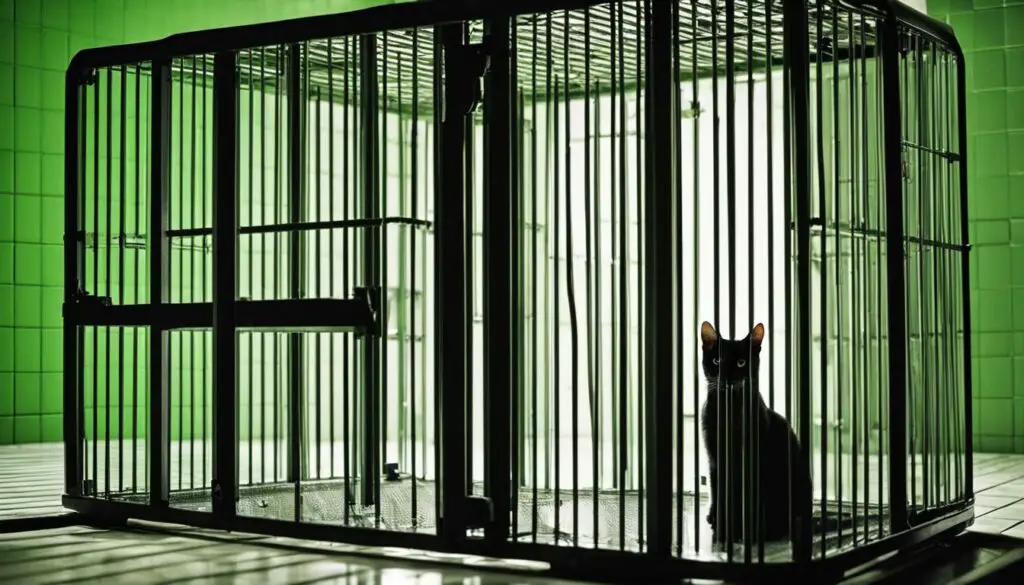
Handling an Aggressive Cat at the Vet Clinic
Dealing with an aggressive cat at the vet clinic can be a challenging experience for both the cat and the veterinary professionals. However, there are strategies and techniques that can help minimize aggression and create a more cat-friendly environment. The goal is to ensure the safety and well-being of the cat while still providing the necessary medical care.
One important aspect of handling an aggressive cat at the vet clinic is using minimal restraint techniques. This involves utilizing gentle restraining methods that allow the cat to feel more secure and reduce the likelihood of aggressive behavior. Veterinary professionals are trained to handle cats in a calm and gentle manner, using techniques such as towel wrapping or the use of a cat bag to provide a sense of security during examinations or procedures.
Sedation is another option that can be considered for aggressive cats during vet visits. In some cases, sedation may be necessary to ensure the safety of both the cat and the veterinary staff. However, sedation should only be used when absolutely necessary and under the guidance of a veterinarian. It is important to weigh the risks and benefits of sedation and consider alternative methods before resorting to it.
Minimizing aggression at the vet clinic: Best practices
- Creating a quiet and calm environment: Ensuring that the waiting area and examination rooms are quiet and free from excessive noise can help reduce stress and anxiety in cats, thus minimizing the likelihood of aggression.
- Using pheromone sprays or diffusers: Feline pheromones, such as those found in products like Feliway, can help create a sense of calm and familiarity for the cat, reducing stress and aggression.
- Providing cat-friendly handling techniques: Veterinary professionals trained in cat behavior can employ specific handling techniques that respect a cat’s natural instincts and preferences, minimizing fear and aggression.
- Implementing positive reinforcement: Reward-based training can be used to help cats associate the vet clinic with positive experiences. By providing treats or praise during and after veterinary procedures, cats can gradually learn to associate these visits with positive outcomes.
By implementing these strategies and techniques, veterinary professionals can help minimize aggression in cats at the vet clinic, creating a safe and more pleasant experience for both cats and their owners.
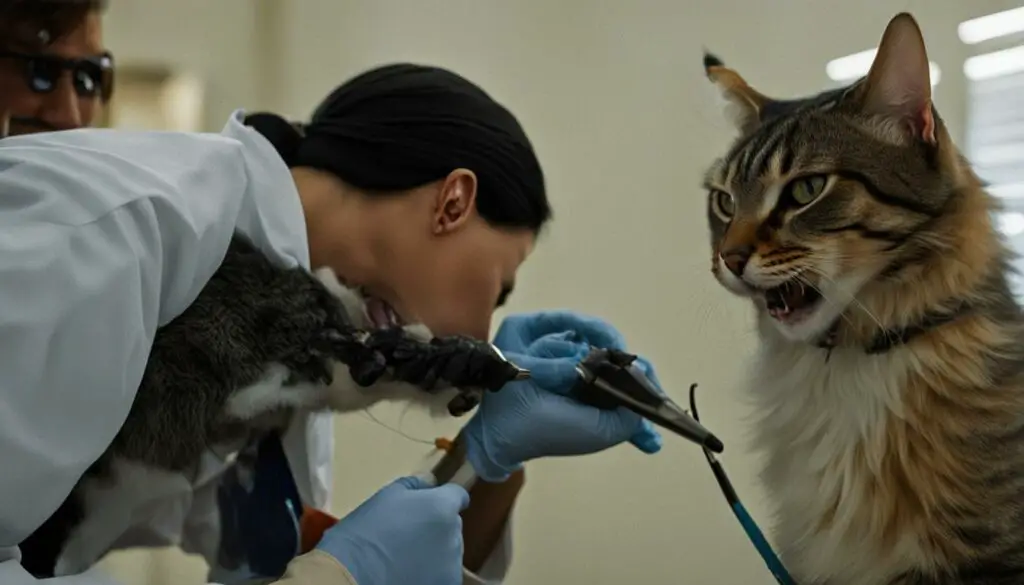
Table: Comparison of Handling Techniques for Aggressive Cats
| Handling Technique | Description |
|---|---|
| Minimal Restraint | Gentle restraining methods that provide a sense of security for the cat, such as towel wrapping or the use of a cat bag. |
| Sedation | The use of medication to calm an aggressive cat during vet visits, only used when necessary and under veterinary guidance. |
| Cat-Friendly Handling | Techniques that respect a cat’s natural instincts and preferences, minimizing fear and aggression. |
| Positive Reinforcement | Reward-based training to help cats associate the vet clinic with positive experiences. |
Reducing Stress for Your Aggressive Cat at the Vet Clinic
When it comes to managing an aggressive cat at the vet clinic, creating a calm and stress-free environment is key. By implementing various techniques and strategies, you can help reduce your cat’s stress and minimize aggression during their visit. Here are some tips for reducing stress for your aggressive cat at the vet clinic:
- Choose a Quiet Waiting Area: Opt for a waiting area that is away from noise and other animals. This can help minimize your cat’s anxiety and prevent triggering their aggressive behavior.
- Cover the Cat Carrier: Placing a breathable cover over the cat carrier can create a sense of security for your cat. It can also help block out any visual stimuli that may cause stress.
- Allow Acclimatization: Give your cat some time to acclimate to the examination room before any procedures are performed. This can help reduce their fear and anxiety.
- Use Pheromone Sprays: Consider using pheromone sprays or diffusers in the examination room. These products release calming pheromones that can help relax your cat and reduce their stress levels.
Additionally, it’s important to communicate with your vet about your cat’s aggression and any specific triggers that you have identified. This will help them tailor their approach and make the necessary accommodations to ensure a safer and less stressful experience for both you and your cat.
| Technique | Benefits |
|---|---|
| Choosing a Quiet Waiting Area | Minimizes anxiety and aggression triggers |
| Covering the Cat Carrier | Creates a sense of security and reduces visual stimuli |
| Allowing Acclimatization | Reduces fear and anxiety before procedures |
| Using Pheromone Sprays | Calms and relaxes cats through the release of calming pheromones |
By implementing these techniques and working closely with your vet, you can help reduce stress for your aggressive cat at the vet clinic. Remember, patience and understanding are key when dealing with an aggressive cat, and a calm and stress-free environment can go a long way in ensuring a successful vet visit.
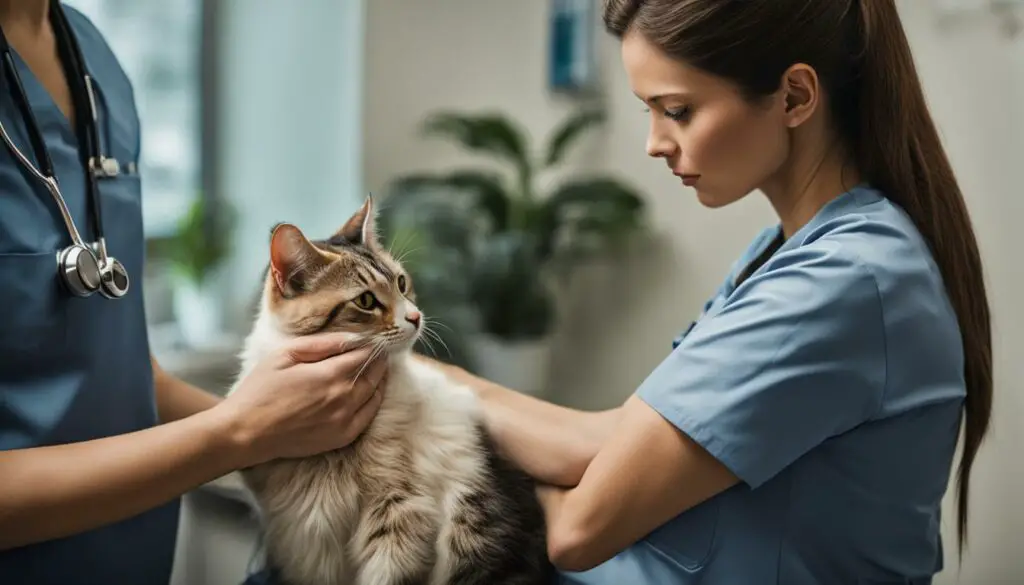
The Role of Medications in Managing Cat Aggression
Aggression in cats can be a challenging behavior to manage, especially when it occurs during vet visits. In some cases, medications may be necessary to help calm and control aggressive behavior in cats. Medications can be used to reduce anxiety, sedate cats for procedures, and aid in long-term behavior modification. It is important to work closely with your veterinarian to determine the appropriate medication and dosage for your cat’s specific needs.
Sedatives are commonly used to help relax cats during vet visits, particularly for cats that exhibit extreme aggression or fear. These medications can help reduce stress and anxiety, making it easier for veterinary professionals to perform examinations and procedures. Sedation can be achieved through oral medications, injectable drugs, or in some cases, inhalation anesthesia.
Behavior modification medications are another option for managing aggression in cats. These medications work by altering the brain chemistry and can be used to address underlying behavioral issues causing aggression. They are typically used for long-term treatment and are most effective when combined with behavior modification techniques, such as positive reinforcement training and environmental modifications.
Types of Medications for Cat Aggression
There are several different types of medications that may be prescribed to manage cat aggression:
- Anxiolytics: These medications help reduce anxiety in cats and can be particularly helpful for cats that become aggressive due to fear or stress. Examples of anxiolytics commonly prescribed for cats include benzodiazepines and selective serotonin reuptake inhibitors (SSRIs).
- Sedatives: Sedatives are used to calm cats and may be administered orally or through injection. Common sedatives used in veterinary practice include acepromazine, dexmedetomidine, and diazepam.
- Antidepressants: Antidepressant medications can be used to address underlying behavioral issues contributing to aggression. Examples of antidepressants commonly prescribed for cats include fluoxetine (Prozac) and amitriptyline.
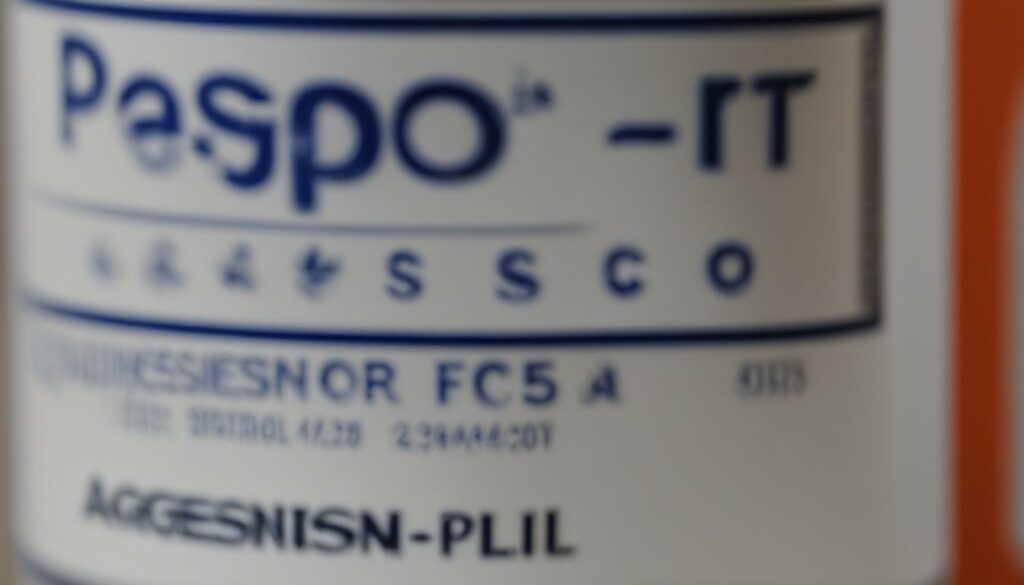
| Medication | Usage | Side Effects |
|---|---|---|
| Benzodiazepines | Reduce anxiety | Drowsiness, increased appetite |
| SSRIs | Address underlying behavioral issues | Decreased appetite, gastrointestinal upset |
| Sedatives | Calming effect | Drowsiness, decreased heart rate |
| Antidepressants | Behavioral modification | Dry mouth, urinary retention |
It is important to note that medications should only be used under the guidance and supervision of a veterinarian. They should be part of a comprehensive treatment plan that includes behavior modification techniques and regular monitoring of your cat’s progress. Your veterinarian will assess your cat’s specific needs and determine the most appropriate medication and dosage.
Veterinary Help for Aggression Issues
If you’re struggling with managing your cat’s aggression, seeking veterinary help is an important step towards finding a solution. Aggression issues can sometimes be complex and require expertise from a veterinary behaviorist. These professionals specialize in understanding and treating behavior problems in animals, including aggressive cats.
Veterinary behaviorists are trained to assess the underlying causes of aggression and develop customized treatment plans. They have a deep understanding of feline behavior and can provide valuable insights into your cat’s specific needs. They may recommend behavior modification techniques, environmental changes, and, if necessary, medication to help address your cat’s aggression.
When consulting a veterinary behaviorist, it’s important to provide them with detailed information about your cat’s aggression, including the frequency, triggers, and any potential medical or environmental factors. They will use this information to develop a comprehensive understanding of your cat’s behavior and create an individualized treatment plan.
| Treatment Options | Pros | Cons |
|---|---|---|
| Behavior Modification | Addresses the root cause of aggression. | Requires commitment and consistency from the owner. |
| Environmental Changes | Creates a more comfortable and stress-free environment for the cat. | May require significant adjustments to the home environment. |
| Medication | Can help manage severe aggression and reduce anxiety. | Potential side effects and the need for long-term use. |
I can’t emphasize enough the importance of seeking professional help when dealing with an aggressive cat. A veterinary behaviorist has the knowledge and experience to guide you through the process and provide the best possible care for your cat.
Oral sedatives for cats may also be considered as a temporary measure to help calm your cat before a vet visit. These sedatives can help reduce anxiety and aggression, making the visit less stressful for both you and your cat. It’s important to follow your veterinarian’s instructions and dosage recommendations when using oral sedatives, as they can have different effects on individual cats.
Remember, aggression issues in cats can be challenging to manage, but with professional guidance, patience, and a commitment to your cat’s well-being, you can help your aggressive cat lead a happier and more peaceful life.
Tips for Dealing with Different Types of Aggression
Dealing with aggression in cats can be challenging, especially when it manifests in different ways. Understanding the specific type of aggression can help you develop effective strategies to manage and prevent it. Here are some tips for dealing with different types of aggression in cats:
1. Play Aggression:
Play aggression is common in young cats and kittens. It typically involves biting, scratching, and chasing. To address play aggression, provide plenty of interactive playtime with toys that allow your cat to exercise their natural hunting instincts. Avoid using your hands or feet as play objects, as this can reinforce aggressive behavior.
2. Fear Aggression:
Fear aggression occurs when a cat feels threatened or scared. It may hiss, growl, or try to escape or hide. To help your cat overcome fear aggression, create a safe and secure environment at home. Gradually expose them to the things that trigger their fear, using positive reinforcement techniques such as treats or play to create positive associations.
3. Petting-Induced Aggression:
Some cats become overstimulated during petting and may respond with aggression. Pay attention to your cat’s body language and stop petting if they show signs of discomfort, such as tail flicking or flattening of the ears. Give your cat space and allow them to approach you for attention on their terms.
4. Status-Induced Aggression:
Status-induced aggression occurs when cats feel threatened by other cats or animals in their territory. Provide separate resources such as litter boxes, food bowls, and resting areas for each cat to reduce competition. Create vertical spaces and hiding spots to allow cats to establish their territories and avoid confrontations.
By understanding the different types of aggression and implementing appropriate strategies, you can effectively manage and reduce aggression in your cat. Remember to consult with your veterinarian or a qualified behaviorist for personalized advice and guidance.
| Type of Aggression | Characteristics | Management Tips |
|---|---|---|
| Play Aggression | Biting, scratching, chasing | Provide interactive playtime, avoid using hands/feet as play objects |
| Fear Aggression | Hissing, growling, hiding | Create a safe environment, gradually expose to triggers with positive reinforcement |
| Petting-Induced Aggression | Overstimulation, tail flicking, ear flattening | Pay attention to body language, allow cat to approach for attention on their terms |
| Status-Induced Aggression | Threatened by other cats/animals | Provide separate resources, create vertical spaces and hiding spots |
Recognizing and Understanding Aggression Body Language
When dealing with an extremely aggressive cat at the vet, it is crucial to be able to recognize and understand their body language. By being aware of the signs of aggression in cats, you can take appropriate measures to prevent incidents and ensure everyone’s safety. Here are some key signs to look out for:
- Dilated pupils: A cat’s pupils will become enlarged when they are feeling threatened or aggressive.
- Flattened ears: Cats will flatten their ears against their head when they are feeling defensive or ready to attack.
- Hissing and growling: These vocalizations are clear indications that a cat is feeling aggressive and wants to be left alone.
- Tail flicking: A cat’s tail will twitch or flick rapidly when they are irritated or agitated.
It is important to note that these behaviors may also be signs of fear aggression in cats. Fear aggression occurs when a cat feels threatened and reacts defensively. Understanding the distinction between fear aggression and other types of aggression can help guide your approach in managing and calming the cat.
By paying attention to these body language signals, veterinary professionals can adapt their handling techniques to minimize stress and aggression during examinations and procedures. Additionally, cat owners can communicate with their veterinarians about their cat’s body language, enabling the veterinarians to provide personalized care and establish a safe environment for the cat during vet visits.

Example Table: Body Language Signs of Aggression in Cats
| Body Language Signs | Description |
|---|---|
| Dilated Pupils | Enlarged pupils indicate a cat’s heightened arousal and aggressiveness. |
| Flattened Ears | When a cat’s ears are pressed flat against its head, it is a sign of defensive aggression. |
| Hissing and Growling | These vocalizations are an expression of a cat’s anger and desire to protect itself. |
| Tail Flicking | A twitching or flicking tail signifies a cat’s irritation or agitation. |
Remember, recognizing and understanding aggression body language is crucial for managing an extremely aggressive cat at the vet. By being aware of these signs and communicating them effectively, vet visits can be safer and less stressful for both the cat and the veterinary team.
Prevention and Early Intervention for Aggressive Behavior
Preventing cat aggression and intervening early are crucial for managing aggressive behavior. By implementing behavior and environment modification techniques, you can create a harmonious and safe space for your feline companion. Here are some strategies to consider:
- Provide environmental enrichment: Ensuring your cat has plenty of mental and physical stimulation can help prevent frustration and aggression. Offer toys, scratching posts, and interactive play sessions to keep your cat engaged and active.
- Establish a routine: Cats thrive on routine and predictability. Consistency in feeding, playtime, and daily interactions can promote a sense of security and stability, reducing the likelihood of aggression.
- Socialize your cat: Early socialization is crucial for cats to develop positive relationships with other animals and humans. Gradually introduce your cat to new experiences, people, and animals in a controlled and positive manner.
- Use positive reinforcement: Reward desired behaviors with treats, praise, and affection. Positive reinforcement can help shape your cat’s behavior and reinforce non-aggressive responses in various situations.
In addition to these strategies, it is essential to monitor your cat’s behavior closely and address any signs of aggression promptly. Early intervention can prevent the escalation of aggressive behavior and improve the overall well-being of your cat.
“Preventing cat aggression and intervening early are crucial for managing aggressive behavior.”
Remember, aggression in cats can have underlying medical causes. If you notice a sudden change in your cat’s behavior or if aggressive episodes become frequent or severe, consult with your veterinarian. They can help rule out any medical issues and provide guidance on behavior modification techniques and potential interventions.
| Behavior Modification Techniques | Benefits |
|---|---|
| Desensitization and counterconditioning | Helps cats associate previously aggressive triggers with positive experiences |
| Redirected play | Encourages appropriate play behavior and redirects aggression towards toys or interactive games |
| Time-outs | Gives cats a chance to calm down and disengage from an aggressive situation |
| Separation and supervision | Prevents aggressive interactions and provides a safe space for all household members |
By taking proactive measures and addressing aggression early on, you can create a peaceful environment for your cat and promote their overall well-being. Remember, every cat is unique, and it may take time to find the most effective strategies for managing aggression. Patience, consistency, and professional guidance can go a long way in helping your cat lead a happy and harmonious life.
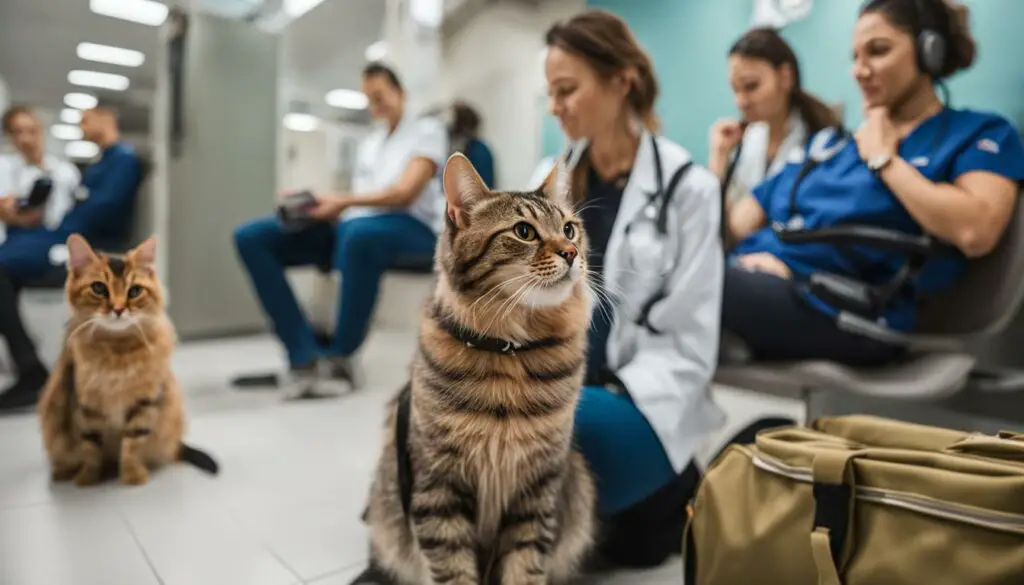
Potential Medical Causes of Cat Aggression
While aggression in cats can sometimes be attributed to behavioral issues, it is important to consider potential medical causes as well. Identifying and addressing these underlying medical conditions can help alleviate aggression and improve your cat’s overall well-being. Here are some potential medical reasons for cat aggression:
- Pain-induced aggression: Cats in pain may exhibit aggressive behavior as a way to protect themselves. Dental disease, arthritis, or other sources of pain can contribute to aggression in cats.
- Hyperthyroidism: An overactive thyroid gland can cause changes in behavior, including aggression. Hyperthyroidism is a common condition in older cats and should be evaluated by a veterinarian.
It is essential to consult with a veterinarian to determine if any medical issues are contributing to your cat’s aggression. They can perform a thorough examination, conduct diagnostic tests if needed, and develop a treatment plan to address the underlying medical condition.
Remember, addressing medical causes of aggression is just one aspect of managing an aggressive cat. It is essential to combine medical treatment with behavior modification techniques and environmental modifications to ensure the best outcome for your cat’s aggression issues.
| Medical Condition | Associated Aggression |
|---|---|
| Pain (e.g., dental disease, arthritis) | Protective aggression |
| Hyperthyroidism | Behavioral changes, including aggression |
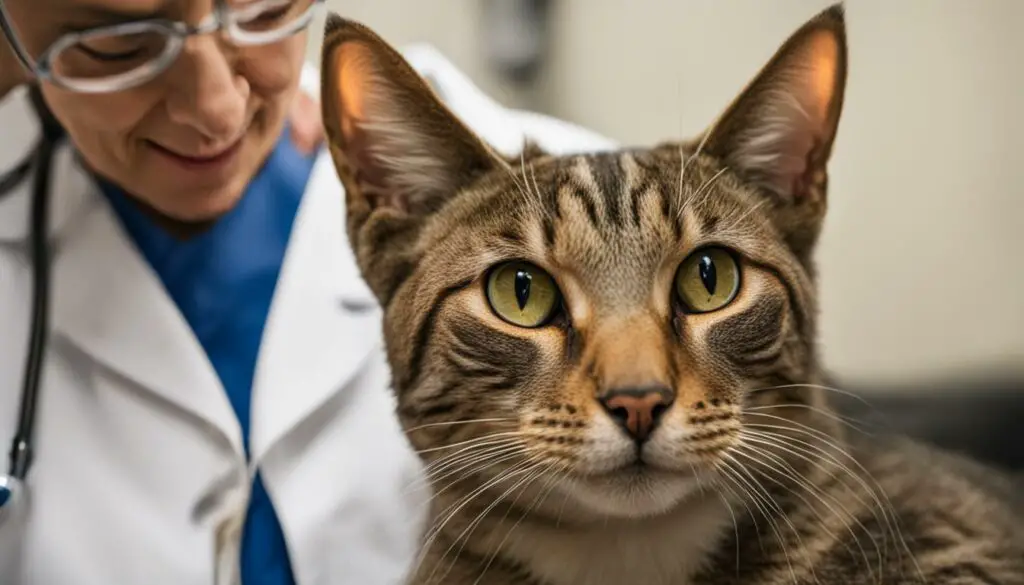
“Addressing medical causes of aggression is just one aspect of managing an aggressive cat. Combine medical treatment with behavior modification techniques and environmental modifications for the best outcome.”
Tips for Managing Aggressive Behavior During Vet Procedures
If you have an aggressive cat, managing their behavior during vet procedures can be challenging. However, with the right strategies and techniques, you can help minimize their aggression and ensure a smoother experience for both your cat and the veterinary staff. Here are some tips to consider:
Proper Restraint Techniques
When handling an aggressive cat during vet procedures, it’s essential to use proper restraint techniques that prioritize their safety and minimize stress. This may involve using towels or blankets to wrap and secure the cat, ensuring that their head is safely controlled, and avoiding any unnecessary pressure that may escalate their aggression. Veterinary professionals are trained in these techniques and can ensure the safest handling of your cat during procedures.
Sedation When Necessary
In some cases, sedation may be necessary to safely conduct vet procedures for aggressive cats. Sedatives can help calm your cat and reduce their aggression, making it easier for the veterinary staff to perform necessary examinations or treatments. It’s important to discuss this option with your veterinarian, who can determine the appropriate sedation protocol based on your cat’s specific needs.
Desensitization Techniques
Desensitization can be a useful technique to help manage aggression during vet procedures. By gradually exposing your cat to the sights, sounds, and sensations they may encounter at the vet clinic, you can help reduce their fear and anxiety. This can be done through positive reinforcement training, where your cat is rewarded for calm behavior in vet-like situations. Consult with a professional trainer or a veterinary behaviorist for guidance on implementing desensitization techniques.
| Procedure | Tips for Managing Aggression |
|---|---|
| Blood Sampling | Use proper restraint techniques to secure your cat and minimize stress. Sedation may be necessary for aggressive cats during this procedure. |
| Vaccinations | Ensure proper restraint of your cat and use distraction techniques, such as treats or toys, to redirect their focus during the vaccination process. |
| Dental Examinations | Sedation may be required for aggressive cats during dental examinations to ensure a thorough examination and necessary treatments. |
Remember, it’s crucial to communicate openly with your veterinarian about your cat’s aggression issues and any specific concerns you may have. They can work with you to develop a customized plan for managing your cat’s behavior during vet procedures and ensuring their overall well-being.
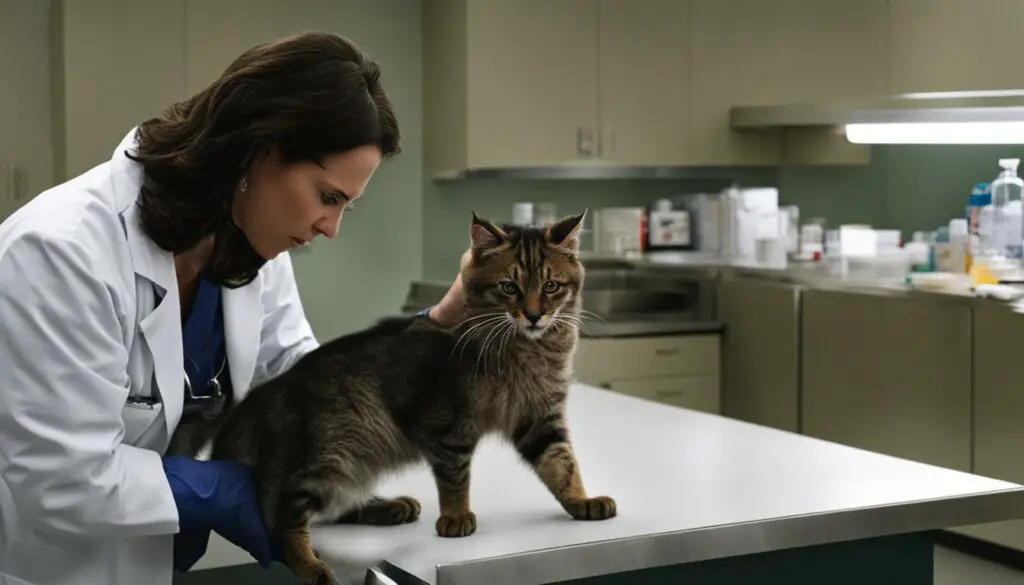
Working with a Veterinary Behaviorist for Aggression Issues
When dealing with aggression issues in your cat, it can be beneficial to seek the expertise of a veterinary behaviorist. These professionals specialize in understanding feline behavior and can provide valuable insights and treatment options for managing aggression. A veterinary behaviorist will work closely with you and your veterinarian to develop a tailored behavior modification plan that addresses the underlying causes of your cat’s aggression.
Behavior modification for aggressive cats involves identifying triggers and implementing strategies to change your cat’s response to those triggers. This may include desensitization and counterconditioning techniques, positive reinforcement training, and environmental modifications. A veterinary behaviorist will guide you through each step of the behavior modification process and provide ongoing support and guidance as you work towards long-term aggression management.
Benefits of Working with a Veterinary Behaviorist
Collaborating with a veterinary behaviorist offers several advantages when it comes to managing your cat’s aggression issues. Firstly, these professionals have extensive knowledge and experience in understanding feline behavior, allowing them to accurately assess and diagnose the underlying causes of aggression. They can also provide you with a comprehensive understanding of your cat’s aggressive behavior, helping you to better interpret their body language and responses.
Additionally, a veterinary behaviorist can prescribe appropriate medications, if necessary, to manage your cat’s aggression. They have a deep understanding of feline pharmacology and can carefully select the right medication and dosage for your cat’s specific needs. It is important to note that medication is typically used as a supplement to behavior modification and is not a standalone solution. The behaviorist will work with you to ensure a holistic approach to aggression management.
Overall, working with a veterinary behaviorist can greatly improve the outcome of your cat’s aggression treatment. Their expertise and guidance will help you develop effective strategies for managing aggression and create a more harmonious environment for both you and your cat.
| Benefits of Working with a Veterinary Behaviorist |
|---|
| Accurate assessment and diagnosis of underlying causes of aggression |
| Comprehensive understanding of feline behavior and body language |
| Prescription of appropriate medications, if necessary |
| Guidance and support throughout the behavior modification process |
| Improved outcome and long-term aggression management |

Section 14: Conclusion
Managing an extremely aggressive cat at the vet can be a daunting task, but it is possible to reduce stress and aggression with the right strategies and preparation. By understanding the underlying causes of aggression, preparing your cat for the vet visit, and creating a calm and stress-free environment, you can help ensure a smoother experience for both your cat and yourself.
Remember, aggression in cats can stem from fear, pain, redirected aggression, or territorial issues. It is crucial to identify the specific cause in order to address it effectively. Seeking veterinary help, including working with a veterinary behaviorist, can provide expert guidance and treatment options for long-term aggression management.
Some cats may require medications or sedation to help manage their aggression during vet visits. It is important to discuss these options with your veterinarian and explore behavior modification techniques to promote positive change in your cat’s behavior. Prevention and early intervention are also key in managing aggression, so consider making environmental modifications and providing positive reinforcement training.
In conclusion, with patience, understanding, and the right approach, you can make your cat’s vet visits less stressful and more manageable. By taking the time to address your cat’s aggression issues, you can ensure their overall well-being and create a positive experience for everyone involved.
FAQ
What causes aggression in cats at the vet?
Aggression in cats at the vet can be caused by fear, pain, redirected aggression, or territorial aggression.
How can I prepare my cat for a vet visit?
To prepare your cat for a vet visit, you can acclimate them to the cat carrier, use pheromone sprays, and keep them calm during the car ride.
How do veterinarians handle aggressive cats?
Veterinarians use minimal restraint techniques, the use of towels for security, and may offer sedation for certain procedures to handle aggressive cats.
How can I reduce stress for my aggressive cat at the vet clinic?
Strategies for reducing stress for your cat at the vet clinic include choosing a quiet waiting area, covering the cat carrier, and allowing the cat to acclimatize to the examination room.
Are medications necessary to manage cat aggression?
In some cases, medications such as sedatives for vet visits or behavior modification medications for long-term treatment may be necessary to manage cat aggression.
When should I seek veterinary help for aggression issues in my cat?
If your cat’s aggression issues persist or worsen, it may be necessary to seek help from a veterinary professional, such as a veterinary behaviorist or a home visit service.
How can I deal with different types of aggression in cats?
Different types of aggression require different management strategies. Tips for dealing with different types of aggression include play aggression, fear aggression, petting-induced aggression, and status-induced aggression.
What are the common body language signs of aggression in cats?
Common body language signs of aggression in cats include dilated pupils, flattened ears, hissing, and tail flicking.
How can I prevent and intervene in cat aggression?
Strategies for preventing and intervening in cat aggression include environmental modifications and positive reinforcement training.
What medical conditions can cause cat aggression?
Potential medical conditions that can cause cat aggression include pain, hyperthyroidism, and dental disease.
How can I manage aggression during vet procedures?
Tips for handling and managing aggression during vet procedures include using proper restraint techniques, sedation when necessary, and desensitization techniques.
When should I work with a veterinary behaviorist for aggression issues?
If cat aggression issues are severe or persistent, it may be necessary to work with a veterinary behaviorist for expert guidance and treatment options.
Source Links
- https://www.hepper.com/how-do-vets-handle-aggressive-cats-vet-answer/
- https://www.nwfdailynews.com/story/lifestyle/pets/2022/10/07/how-can-you-keep-your-cat-dog-calm-vets-office-safety-tips/8184894001/
- https://www.vet.cornell.edu/departments-centers-and-institutes/cornell-feline-health-center/health-information/feline-health-topics/feline-behavior-problems-aggression








